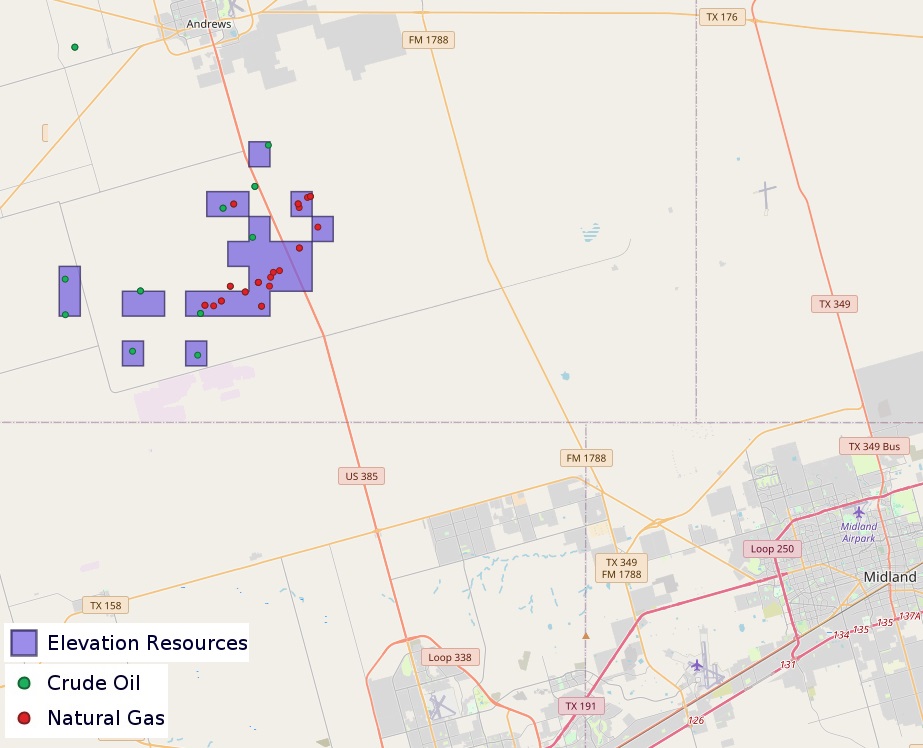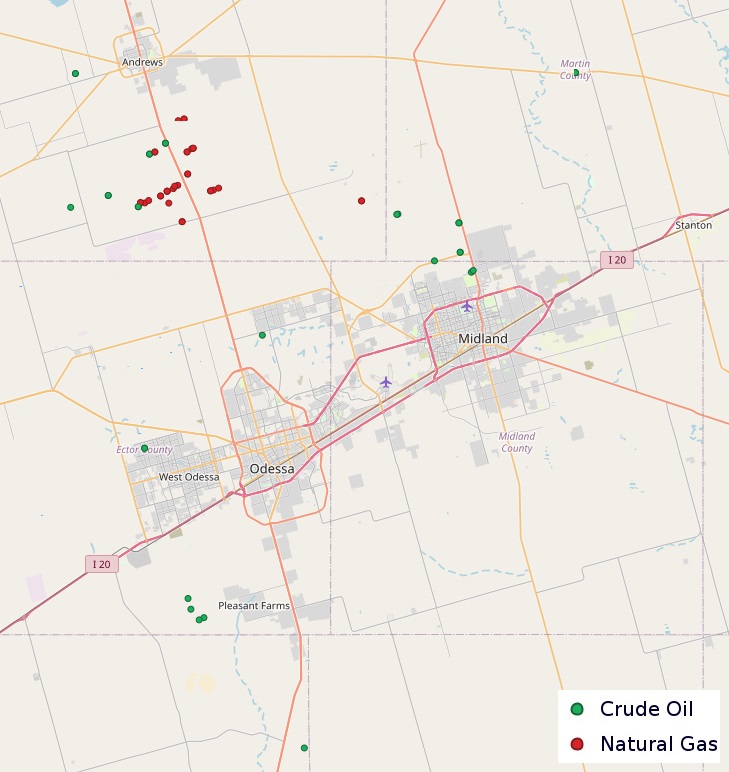
E&Ps are reaching under the Permian’s popular benches for new drilling locations. Analysts think there are areas of the basin where the Permian’s deeper zones can compete for capital. (Source: Shutterstock)
The need for low-cost drilling inventory is fueling a record run of Permian consolidation. But a small group of Permian operators are exploring zones deeper underground for future drilling runway.
Oil and gas producers most commonly target the Spraberry and Wolfcamp intervals in the Midland Basin. In the more western Delaware Basin, the Bone Spring and Wolfcamp formations are the common targets.
But a Hart Energy analysis of Texas Railroad Commission (RRC) records shows that activity targeting the region’s deeper formations, like the Barnett Shale, Woodford, Strawn and Devonian intervals, has increased notably in recent years as producers search for new drilling locations.
The deeper dives by a growing list of Permian operators doesn’t surprise Steve Pruett, CEO of Midland, Texas-based Elevation Resources; Pruett also serves as chair of the Independent Petroleum Association of America.
Elevation Resources drilled and completed the first Barnett horizontal discovery well in West Texas—in the Central Basin Platform—in 2016.
“The results were such that we sold everything else and focused all of our capital and cash flow on developing that asset,” Pruett told Hart Energy.

At that time, the Wolfcamp, Spraberry and Bone Spring intervals were more widely tested, shallower and cheaper to drill than the Barnett Shale—so they attracted the most investment.
But nearly a decade later, there are a lot fewer of those low-cost Wolfcamp, Spraberry and Bone Spring drilling locations, often referred to as “Tier 1 locations,” to go around.
Scarcity of high-quality drilling locations has been a major driver of the consolidation sweeping across the shale patch.
Two of the Permian’s largest producers and landowners, Pioneer Natural Resources and Endeavor Energy Resources, both agreed to multibillion-dollar sales last year: Pioneer is in the process of being acquired by Exxon Mobil for $60 billion; Endeavor is selling to Diamondback Energy for $26 billion.
Occidental Petroleum is pursuing a smaller $12 billion takeout of private Midland producer CrownRock LP. Smaller operators Civitas Resources, Ovintiv, Vital Energy and Matador Resources also grew their Permian footprints through acquisition last year.
Companies such as Marathon Oil and Continental Resources haven’t been as acquisitive in the current M&A cycle. But they’re among the E&Ps leading the pack in delineating the Woodford zone in the eastern Delaware Basin.
“I believe the Barnett, the Woodford, the deeper zones that companies are now starting to test or assess, or even lease, is about inventory exhaustion,” Pruett said.
Compared to a Spraberry or Wolfcamp well, these deeper horizons are generally gassier and more expensive to drill, Pruett said. But operators and industry analysts believe the Permian’s deeper zones hold economic upside.
“As costs have come down and [operators] are able to leverage existing infrastructure, it can start to look like a Tier 1,” Pruett said, “but it’s not as prolific as the best Wolfcamp B or A zone opportunities.”
RELATED
CEO: Continental Adds Midland Basin Acreage, Explores Woodford, Barnett
Woodford watch
Marathon Oil is leading appraisal of the Woodford zone in the Delaware Basin, RRC data shows.
But Continental, the private E&P owned by billionaire Bakken wildcatter Harold Hamm, is also drilling Woodford tests on its Delaware asset.
Both companies own acreage in a Woodford “sweet spot” across Winkler and Ward counties, according to Jennifer McNally, Wood Mackenzie senior upstream Lower 48 research analyst.
Delineation activity by Marathon and Continental has helped define what a prospective area looks like within the broader Woodford play in the eastern Delaware, McNally said.

To the west, the Woodford zone becomes too deep and generates too much gas. To the east, the formation starts to thin and shallows out approaching the Central Basin Platform.
State records show a handful of operators drilled horizontal Woodford Shale wells in Winkler and Andrews counties in the early- to mid-2010s. But wells drilled further north and east of Marathon and Continental’s acreage have underperformed in comparison, according to WoodMac’s analysis.
“We model between 1,500 and 2,400 locations remain within the prospective area,” McNally said.
Marathon Oil, through wholly owned subsidiary Bosque Texas Oil LLC, drilled its first Woodford wells in 2019 on the G.W. O’Brien et al lease along the Ward-Winkler county line.
The discovery well, G.W. O'Brien et al No. 2H, reached a true vertical depth of 13,974 ft and featured a relatively modest 3,379-ft lateral.
The next year, Bosque petitioned the RRC to designate rules and regulations for the Ruppel-Woodford Field in Ward and Winkler counties; The interval ranges between about 11,400 ft and 14,000 ft.
Bosque has submitted data on 13 more wells targeting the Ruppel-Woodford since drilling the discovery well in 2019.
Continental Resources, a mainstay in the Midcontinent and a leading producer in the Bakken, made its Delaware Basin debut in 2021 through a $3.25 billion acquisition from Pioneer Natural Resources.
The deal included blocky acreage in the southern Delaware—Reeves and Pecos counties, Texas—but also gave Continental a footprint near Marathon’s Woodford projects.
It didn’t take long before wildcatting Continental was testing the Woodford zone on its own Delaware asset.
Continental spudded its first Ruppel-Woodford wells on university lands in Winkler County in July 2022; Both wells were brought online in the spring of 2023.
No. 1H, reaching a total depth of 16,249 ft with a 9,700-ft lateral, produced 187,586 bbl between March 2023 and January 2024, per RRC data.
A second Woodford well, No. 2H (15,423-ft depth; 8,621-ft lateral), produced 61,161 bbl over the same period.
Continental CEO Doug Lawler, in a recent interview with Hart Energy, said deep-zone exploration was top-of-mind for the company when entering the Delaware.
“We believe where we sit today with current technology, operating experience and expertise that there are some really good opportunities [in the Barnett and Woodford] for exploration and development,” Lawler said.
RELATED
SUPER DUG: E&Ps Explore Emerging Basins, Deeper Zones in Inventory Hunt
Barnett bonanza
The Central Basin Platform continues to attract investment from Pruett’s Elevation Resources and other producers developing the Barnett interval.
But companies including Occidental Petroleum, Diamondback Energy and Continental are moving the Barnett’s heat map further south and east into the Midland Basin.
Occidental has been targeting the Emma Barnett Field with several wells on the South Curtis and Johnson ranches in Midland and Martin counties. Occidental’s recent Barnett wells in the area reached depths of about 11,200 ft.
Diamondback has drilled a handful of wells targeting the Peart Barnett Field along the Ector-Crane county line. Diamondback’s wells have reached depths between 10,500 ft and 11,500 ft.
Continental entered the Permian through the Delaware Basin but has quietly been collecting leases in the Midland Basin, Lawler confirmed.
Continental has also targeted the Emma Barnett with wells drilled in the area near Gardendale, Texas, between Midland and Odessa.
RRC data show that ConocoPhillips is also drilling deeper into the Barnett: ConocoPhillips subsidiary COG Operating LLC brought a 12,500-ft Barnett well online in Ector County last summer—not far from Continental’s Gardendale lease.
Occidental and Diamondback have also tested the Wolfcamp D formation, which is about 1,000 ft shallower than the Barnett Shale.
WoodMac’s inventory estimates range around 3,300 Wolfcamp D locations, with breakevens at $60/bbl WTI and 6,100 locations at $75/bbl.
“Expect these numbers to change as cost assumptions evolve,” McNally said.

RELATED
Is Double Eagle IV the Most Coveted PE-backed Permian E&P Left?
Cost curve
Exploration of the Permian’s deeper, undeveloped zones so far suggests some economic upside. But exploring and testing new benches also carries risks.
The Permian isn’t a place that’s historically attracted considerable exploration investment, Lawler said. That’s because operators generally have the Permian’s most popular benches figured out at this point.
The Barnett Shale, the Woodford and other deeper Permian formations can vary drastically depending on where exactly a well is drilled.
The Emma Barnett Field can differ widely even on Elevation Resources’ acreage position in Andrews County, which is about 20 miles across, Pruett said.
Initial productivity of Elevation’s Barnett wells to the southeast, toward the Midland Basin, have been higher than the Barnett wells drilled closer to the Central Basin Platform. But those wells tend to have higher gas-to-oil ratios and productivity declines faster.
Other wells have shown higher oil recoveries and a lower gas-oil ratio, but Elevation sees lower rates of return because the initial output wasn’t as high.
“Even within 20 miles—or even closer, 5 miles—we see that variability in gas-oil ratio and [initial production],” Pruett said.
The deeper you go, the less is known. That uncertainty can be daunting for operators about to pay millions of dollars to drill a well two to three miles underground.
But amid the frenzied hunt for drilling runway in the basin, Permian operators appear to be keeping the exploration option on the table.
Those zones may not be able to compete with core Wolfcamp A or Wolfcamp B drilling locations, McNally said.
On average, the rock quality of these deeper zones is “considerably worse” than the shallower, more targeted zones, said Brandon Myers, head of research for energy analytics provider Novi Labs.
But the Wolfcamp D, Barnett and Woodford can add a few thousand incremental locations to the Permian that breakeven below $65/bbl.
D&C well costs for the better-performing areas being proven out so far are on par with Wolfcamp A wells and are below $10 million, according to WoodMac.
“Especially on the flanks of the Central Basin Platform, where favorable thermal conditions coincide with shallower depth and higher porosity, the three deep benches outperform the Wolfcamp A in terms of capital efficiency,” McNally said.
“There are pockets that actually look on par with some of the rock that’s being drilled today,” Myers said.
As economics improve and drilling technologies evolve—themes that have both played out in the Permian over the past decade—lower-tier plays can climb the portfolio ladder to become Tier 1 locations.
RELATED
Small Play, Big Wells: Permian Basin’s Horizontal Eastern Shelf
Recommended Reading
Trump Axes Chevron's Venezuela Oil License, Citing Lack of Electoral Reforms
2025-02-26 - U.S. President Donald Trump on Feb. 26 said he was reversing a license given to Chevron to operate in Venezuela.
Paisie: Impact of Tariffs, Sanctions and ‘Drill, Baby, Drill’
2025-03-07 - The U.S. has the advantage with tariffs on Canada, but sanctions and pleas for increased oil supply are unlikely to be effective.
Belcher: Tariff Growing Pains Will Help US Achieve Energy Dominance
2025-04-03 - Tariffs may bring short-term pain, but Trump is aggressively pursuing goals that benefit the U.S., says Cornerstone Government Affairs’ Jack Belcher.
Impacts of Trump’s Tariffs on North American Energy Markets
2025-03-06 - On March 6, President Trump granted exemptions on tariffs for numerous goods imported from Mexico and Canada until April 2, when Trump intends to impose another set of retaliatory tariffs on various countries. What are their immediate and long-term impacts and how can companies mitigate their effects?
US Tariffs on Canada, Mexico Hit an Interconnected Crude System
2025-03-04 - Canadian producers and U.S. refiners are likely to continue at current business levels despite a brewing trade war, analysts say.
Comments
Add new comment
This conversation is moderated according to Hart Energy community rules. Please read the rules before joining the discussion. If you’re experiencing any technical problems, please contact our customer care team.





